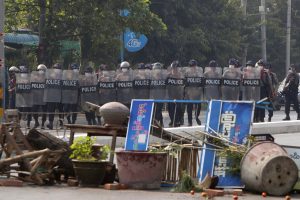At least 18 people were killed and 30 wounded when Myanmar security forces opened fire on anti-coup protests in several cities on Sunday, the deadliest day since the start of the uprising against the military coup on February 1.
In a statement, the U.N. Human Rights Office said that it had “credible information” that at least 18 people were killed and 30 were wounded. “Deaths reportedly occurred as a result of live ammunition fired into crowds in Yangon, Dawei, Mandalay, Myeik, Bago, and Pokokku,” a U.N. spokesperson said in the statement, adding that the forces also used tear gas, flash-bang grenades, and stun grenades to quell protests.
A month on from the military’s seizure of power, popular resistance to the coup government shows no signs of slackening. Across the weekend, hundreds of thousands turned out to demand the restoration of the elected government of Aung San Suu Kyi and the National League for Democracy (NLD), as well as more far-reaching democratic reforms.
After a week of growing tension, security forces began using progressively tougher tactics to disperse the growing protests on Saturday, making scores, if not hundreds, of arrests. According to the Assistance Association for Political Prisoners (AAPP), 854 people had been arrested, charged, or sentenced in relation to the coup as of Saturday.
This set the stage for the use of violence on Sunday. According to Myanmar Now, thousands gathered in the morning at Yangon’s Hledan junction, which has been a major rallying point during three weeks of daily protests. Within minutes, police began attacking the crowd with stun grenades, and then began firing shots. At least two protesters were killed in the morning around Hledan, while reports emerged of police using water cannon, tear gas, and live ammunition on protesters in other cities. Meanwhile, the toll of arrests continued to grow. According to AAPP, the number of those arrested, charged, or sentenced rose to total of 1,132 people on Sunday.
Those arrested on Sunday included at least six journalists. Shin Moe Myint, a 23-year-old freelance photojournalist, was beaten by several police officers before being taken away. Thein Zaw, a photographer for the Associated Press was also arrested and remains in police custody.
Despite the crackdowns, the resistance of the citizenry continues to prevent the junta led by Sen. Gen. Min Aung Hlaing from resuming even a semblance of normal government functions. In Monywa and Mandalay, citizens have reportedly set up “people’s governing bodies,” pledging their loyalty to the Committee Representing Pyidaungsu Hluttaw (CRPH), a shadow parliament formed by elected lawmakers, mostly from the NLD. Across the country, government affairs have shuddered to a halt.
The weekend’s violence came as Myanmar’s ambassador to the United Nations gave an emotional address to the U.N. General Assembly, in which he publicly broke with the junta, pledged his support to the CRPH, and raised a three-finger salute in solidarity with anti-coup protesters. “In addition to the existing support, we need further strongest possible action from the international community to immediately end the military coup, to stop oppressing the innocent people, to return the state power to the people, and to restore the democracy,” Kyaw Moe Tun said.
The military’s use of lethal force on Sunday was accompanied by a flurry of condemnatory statements from Western governments and various United Nations offices. On Twitter, State Department spokesman Ned Price said, “The international community condemns Burmese security forces’ brutal acts of violence against the people of Burma. The United States strongly supports the right to freedom of expression and the people’s aspirations for the restoration of the democratically-elected government.” U.S. National Security Advisor Jake Sullivan also warned of further actions targeting those responsible for the violence, in addition to the two rounds of targeted sanctions already announced.
Yet only a month in to what could well be a protracted political crisis, the statements of condemnation are already taking on a formulaic quality, and it remains unclear exactly what the outside world can do to impact the situation inside Myanmar.
It has now become apparent that a return to the awkward power sharing arrangement between the NLD government and the military is not possible, even if Min Aung Hlaing and the military high command was willing to agree to it. Over the past three weeks, the protest movement has become increasingly radical in its demands, which now encompass a desire to wipe the hated military from the country’s political life once and for all.
Unable to reverse course, unwilling to compromise, and prevented by the populace from proceeding smoothly with business as usual, the junta seems increasingly likely to use force to secure its hold on power – whatever the outside world might think.

































